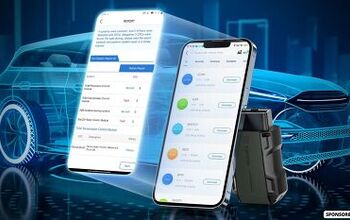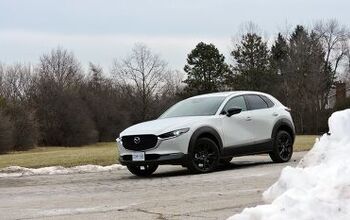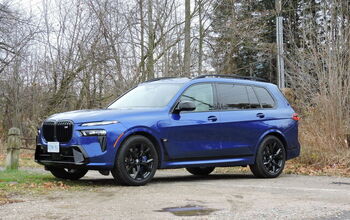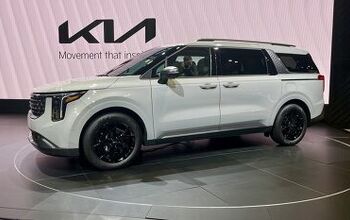Nissan Introduces 'Approaching Vehicle Sound for Pedestrians' System for New Leaf EV

Ahead of any possible legislation requiring electric cars and hybrids to come equipped with noise-makers, Nissan is announcing the introduction of what it calls the ‘Approaching Vehicle Sound for Pedestrians’ system for its new Leaf electric vehicle. The system finds a balance between driver comfort and alerting pedestrians of an approaching vehicle. The “sine-way sound system” emits a changing tone from 2.5kHz at the high end to a low of 600Hz and changes based on vehicle speed and whether the car is speeding up or slowing down. There’s an intermittent back-up sound and even a start up sound designed to let those standing near the car know it is preparing to move. (Having tested a few electric cars ourselves, drivers are sure to appreciate the start-up sound that lets them know their car is ready to go).
The sound for this new system comes from a speaker in the engine compartment and can be turned off temporarily by the driver. It does, however, revert to being on every time the vehicle is started up. Nissan has designed it to shut off automatically at speeds beyond 30 km/h (18.6 mph) and come back on at speeds of 25 km/h (15.5 mph)
Nissan is currently showing the system (and the new Leaf EV) to journalists at its Oppama test track in Japan.
Along with the Leaf, Nissan plans to offer the Approaching Sound for Pedestrians system in the upcoming Infiniti M35 Hybrid.
Official release after the jump:
PRESS RELEASE
THE ‘NEW CAR’ EXPERIENCE
– Nissan demonstrates the affordable, 100% electric, zero-emission Nissan LEAF –
– Company also showcases audio-alert system for pedestrians –
YOKOHAMA (June 11, 2010) – Nissan Motor Co., Ltd. (NML) has invited nearly 500 people to experience the world’s first mass-production, 100% electric, zero-emission car – Nissan LEAF – at the company’s Oppama test track in a world-exclusive preview from June 11-19, 2010.
Media, Nissan shareholders, government officials, analysts and some of the first customers to place reservations for Nissan LEAF will get the chance to experience the benefits of this practical, affordable and fun to drive all-electric car when they get behind the wheel of the first production test units.
Nissan LEAF, is a ‘new car’ in every sense of the word and redefines the driving experience, setting new standards in handling, acceleration and comfort in its class. Nissan LEAF officially goes on sale beginning in December.
Since the 100% electric, zero-emission concept vehicle was unveiled last August at the grand opening of the new Nissan Global Headquarters, the company has been continually refining Nissan LEAF for the October start of production.
Among the enhancements to the test units is the “Approaching Vehicle Sound for Pedestrians” system, which also will be used in the Nissan Fuga hybrid, slated for sale in fall 2010.
The system makes it easy for those outside to hear the vehicle approaching, but the sounds do not distract the driver and passengers inside. Thus, the needs of pedestrian safety, as well as driver and passenger comfort, are met. The sound system is the first of its type to be introduced by an automaker.
Nissan believes the 100 percent electric Nissan LEAF has the potential to be the transformative beginning of a new approach to personal transportation. No tailpipe emissions from this global vehicle mean no CO2 or other gases released into the atmosphere.
In addition to reducing air pollution, Nissan LEAF and other electric vehicles (EVs) reduce noise pollution, making them transformative in yet another way. Unlike their gasoline-powered cars, EVs and hybrids run quietly. Today’s noisy traffic corridors have the potential to possess an almost serene ambience if populated with cars and trucks that are quieter.
While silence is golden, it does present practical challenges. In response to public concern that quiet EVs and hybrids can surprise pedestrians and the visually impaired as they approach, Nissan has developed a set of distinctive sounds that will come standard with Nissan LEAF to ensure a positive experience for drivers, passengers and pedestrians alike.
In developing the sound system, Nissan studied behavioral research of the visually impaired and worked with cognitive and acoustic psychologists. After looking at applied original technology developed to reduce vehicle noise and conducting tests in Japan and abroad, the Approaching Vehicle Sound for Pedestrians system was created.
The sine-wave sound system sweeps from 2.5kHz at the high end to a low of 600Hz, an easily audible range across age groups. Nissan worked to avoid a sound range that would add unnecessary noise to the environment (around 1,000Hz).
Depending on the speed and status (accelerating or decelerating) of Nissan LEAF, the sound system will make sweeping, high-low sounds. For instance, when Nissan LEAF is started, the sound will be louder, so a visually impaired person would be aware that a nearby car was beginning operations. And when a car is in reverse, the system will generate an intermittent sound. The sound system ceases operation when Nissan LEAF tops 30km/h and enters a sound range where regular road noise is high. It engages again as Nissan LEAF slows to under 25km/h.
The system is controlled through a computer and synthesizer in the dash panel, and the sound is delivered through a speaker in the engine compartment. A switch inside the vehicle can turn off sounds temporarily. The system automatically resets to “On” at the next ignition cycle.
Nissan LEAF will be on sale in Japan, the United States, Portugal and the Netherlands starting in December and in the United Kingdom and Ireland starting February 2011. Nissan plans to begin mass marketing Nissan LEAF in 2012.
Production will start in October at the Oppama plant in Japan. The second half of 2012 will see production at the Smyrna, Tenn., plant in the U.S., followed by production in the UK at the Sunderland plant in 2013. Annual Nissan LEAF production for Oppama is 50,000 units. The Lithium-ion battery that powers Nissan LEAF will be produced by Nissan’s joint-venture with NEC, AESC (Automotive Energy Supply Company). Originally planned annual battery production capacity at AESC was 65,000 units including 54,000 units for EV. However, AESC plans to increase annual battery production capacity for EV to 90,000 units by 2011, foreseeing an upward trend in future demand.
Note: The Approaching Vehicle Sound for Pedestrians system conforms to guidelines set by Japan’s Ministry of Land, Infrastructure and Transport in its report, “Measures for dealing with the silence of hybrids and similar cars,” released in January.
Related images and sound samples of the Approaching Vehicle Sound for Pedestrians can be downloaded from the Nissan News Room (www.nissan-newsroom.com/JPN/en/).

With AutoGuide from its launch, Colum previously acted as Editor-in-Chief of Modified Luxury & Exotics magazine where he became a certifiable car snob driving supercars like the Koenigsegg CCX and racing down the autobahn in anything over 500 hp. He has won numerous automotive journalism awards including the Best Video Journalism Award in 2014 and 2015 from the Automotive Journalists Association of Canada (AJAC). Colum founded Geared Content Studios, VerticalScope's in-house branded content division and works to find ways to integrate brands organically into content.
More by Colum Wood
































Comments
Join the conversation
Nissan needs to think outside of the box... "Car Tones. The new thang! The driver can redefine any number of sounds on their car, from the Reverse Movement, to the Engine Start sounds. From the user-selectable Exhaust Tone to the Pedestrian Warning. Only 99 cents each."